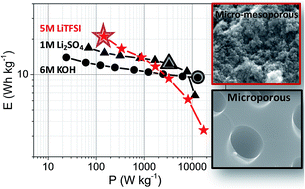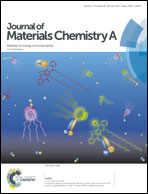One-pot synthesis of highly activated carbons from melamine and terephthalaldehyde as electrodes for high energy aqueous supercapacitors†
Abstract
In this work we report the preparation of porous carbons with very large specific surface areas (over 3000 m2 g−1) by a simple all-in-one route that involves the simultaneous polymerization, carbonization and in situ activation of a mixture of melamine and terephthalaldehyde. The influence that different activating agents (KOH and a eutectic mixture of KOH and NaOH) have on the polymerization process and thus the final textural properties of the carbons is also explored. Materials were characterized by X-ray diffractometry (XRD), Raman spectroscopy, scanning electron microscopy (SEM), transmission electron microscopy (TEM), thermal analysis (TG/DTA) and nitrogen adsorption–desorption at −196 °C. It was found that carbons prepared in the presence of KOH showed a hierarchical multimodal pore-size distribution that combines large micropores and medium-size mesopores while those carbons obtained in the presence of the KOH–NaOH mixture exhibited a narrower distribution within the micropore range and small mesopores. Both materials were tested as electrodes for symmetric supercapacitors using three different aqueous electrolytes, namely 6 M KOH, 1 M Li2SO4 and 5 M LiTFSI (lithium bis(trifluoromethanesulfonyl)imide), which allowed their steady cycling at 1.2, 1.8 and 2.2 V, respectively. The different performance between both carbons working in different electrolytes is discussed and related to their textural features. The hierarchical micro–mesoporosity favored a good diffusion of ions when working with LiTFSI, which allows achieving very high energy densities of 21 W h kg−1 at 0.14 kW kg−1. For moderate requirements in terms of energy and power density, the same micro/mesoporous material can provide 12.4 W h kg−1 at 3.3 kW kg−1 for 104 cycles using Li2SO4 as the electrolyte. Finally, both mesopore-containing and mesopore-free materials can provide very high capacitance values up to 360 F g−1, a very fast response and excellent cycling performance when working in 6 M KOH, being suitable candidates for high power applications.



 Please wait while we load your content...
Please wait while we load your content...